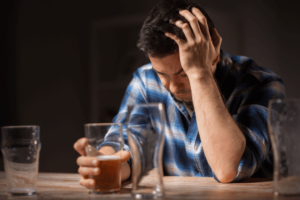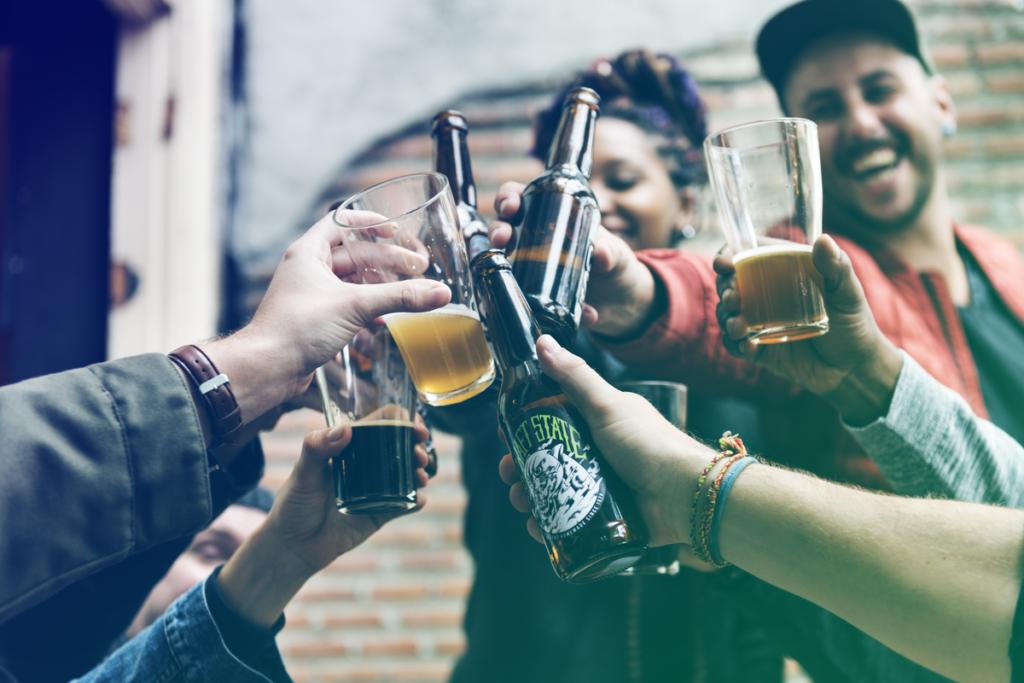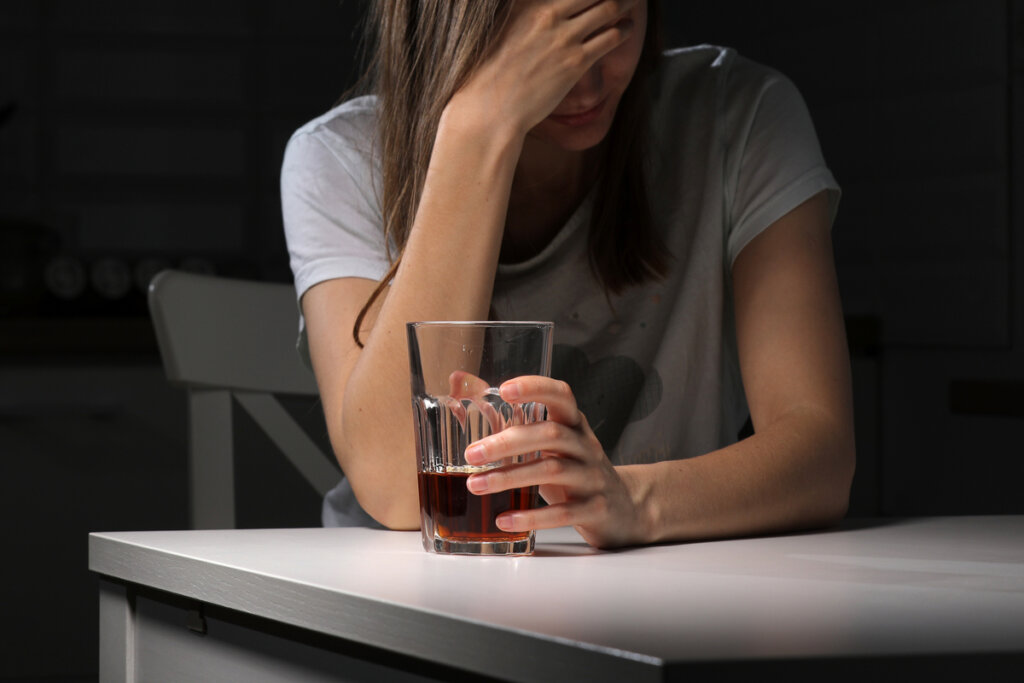Drunkorexia: What is It?

Drunkorexia is an eating disorder. The drunkorexic person restricts the calories in their food to make room for calories in alcoholic beverages. In other words, they seek to control their weight to compensate for planned alcohol consumption.
In recent years, the term drunkorexia has been used to describe a new phenomenon with a high incidence in subjects aged between 18 to 26. As a matter of fact, studies indicate that 39 to 46 percent of college students report intentionally restricting and altering their eating behaviors before drinking alcohol (Giles et al. 2009; Roosen and Mills, 2015).
In general, those who manifest this type of behavior know the energy content of alcoholic beverages and try to balance their food intake to prevent an increase in their body weight. Unfortunately, maintaining this balance leads them to drastically stop eating in order to consume alcohol excessively (Martínez et al. 2014).
During alcoholic intake, the drunkorexic person eats to avoid the damage caused by alcohol on an empty stomach. However, another problem is that these foods are usually unhealthy. For example, sweets, or french fries. Therefore sufferers experience problems due to an unhealthy diet (Villarino, 2012).

Drunkorexia: components and main activities
Drunkorexia has three main aspects. These are alcohol use or abuse, restriction of food intake, and excessive physical activity. A sufferer from this condition will:
- Count their daily calorie intake to ensure that they don’t gain weight while consuming alcohol.
- Skip meals to conserve calories so they can consume alcoholic beverages.
- Exercise excessively to offset the calories they consume from alcoholic beverages.
- Consume an extreme amount of alcohol in order to vomit previously eaten food.
What problems can drunkorexia cause?
It’s extremely risky to reduce the calories in food in favor of the calories that alcoholic beverages provide. Furthermore, these risks can be compounded by the combination of eating disorders and heavy alcohol use. The problems that are derived from these behaviors are the following:
- Drinking on an empty stomach can lead to an unexpected degree of intoxication. This inhibits judgment and increases the risk of physical injury.
- The metabolism of alcohol increases the need for certain nutrients. However, restricting food intake reduces their availability. This combination increases the risk of nutrient deficiencies.
- Drinking alcohol after exercising inhibits protein synthesis and muscle repair. This slows down the recovery process and minimizes potential improvements in fitness.
- Drinking alcohol can lead to a tendency to engage in unhealthy eating behaviors.
- Women who restricted their calories in this manner were more likely to report memory loss, injury, abuse, and unprotected sex when drinking. Men were more likely to get into a physical fight (Giles et al. 2009).

Population at risk
In a study that examined calorie restriction among freshmen before planned alcohol consumption, it was found that 99 out of 695 (14 percent) of freshmen reported restricting calories before drinking. Six percent claimed this behavior was to avoid weight gain and ten percent said it was to speed up the effects of alcohol (Burke et al. 2010).
In a survey of 107 college students, it was found that 59.8 percent who reported drinking alcohol also reported self-induced vomiting after drinking. Participants who reported self-induced vomiting also said they experienced more symptoms of bulimia nervosa, as well as depression (Blackmore & Gleaves, 2013).
In another survey of 1000 college students, it was found that 14 percent of students restricted calories before alcohol consumption (25 percent of women and 11 percent of men). Nine percent did it to avoid gaining weight and four percent to get drunk faster. Out of this 14 percent who restricted their calories, 64 percent did it to avoid weight gain, 25 percent to get drunk faster, and two percent due to peer pressure (Osborne, Sher, and Winograd, 2011).
Further research
In Australia, following along the same lines of research, another study was conducted with 139 undergraduate university students between the ages of 18 and 29. They completed the Compensatory Eating and Behaviors in Response to Alcohol Consumption Scale (CEBRACS) self-report to detect the symptoms of drunkorexia.
The results showed that more than 79.1 percent of the participants reported participating in drunkorexic behaviors. The analysis showed that excessive alcohol consumption, the social norm of thinness, and the social norm of drinking were positively related to these behaviors (Knight & Simpson, 2013).
Previous research suggests that college students are a population at risk for drunkorexia. This may be due to social pressure to consume, social standards of beauty, a coping mechanism against anxiety and depression, or one in response to college stress.
Drunkorexia is an eating disorder. The drunkorexic person restricts the calories in their food to make room for calories in alcoholic beverages. In other words, they seek to control their weight to compensate for planned alcohol consumption.
In recent years, the term drunkorexia has been used to describe a new phenomenon with a high incidence in subjects aged between 18 to 26. As a matter of fact, studies indicate that 39 to 46 percent of college students report intentionally restricting and altering their eating behaviors before drinking alcohol (Giles et al. 2009; Roosen and Mills, 2015).
In general, those who manifest this type of behavior know the energy content of alcoholic beverages and try to balance their food intake to prevent an increase in their body weight. Unfortunately, maintaining this balance leads them to drastically stop eating in order to consume alcohol excessively (Martínez et al. 2014).
During alcoholic intake, the drunkorexic person eats to avoid the damage caused by alcohol on an empty stomach. However, another problem is that these foods are usually unhealthy. For example, sweets, or french fries. Therefore sufferers experience problems due to an unhealthy diet (Villarino, 2012).

Drunkorexia: components and main activities
Drunkorexia has three main aspects. These are alcohol use or abuse, restriction of food intake, and excessive physical activity. A sufferer from this condition will:
- Count their daily calorie intake to ensure that they don’t gain weight while consuming alcohol.
- Skip meals to conserve calories so they can consume alcoholic beverages.
- Exercise excessively to offset the calories they consume from alcoholic beverages.
- Consume an extreme amount of alcohol in order to vomit previously eaten food.
What problems can drunkorexia cause?
It’s extremely risky to reduce the calories in food in favor of the calories that alcoholic beverages provide. Furthermore, these risks can be compounded by the combination of eating disorders and heavy alcohol use. The problems that are derived from these behaviors are the following:
- Drinking on an empty stomach can lead to an unexpected degree of intoxication. This inhibits judgment and increases the risk of physical injury.
- The metabolism of alcohol increases the need for certain nutrients. However, restricting food intake reduces their availability. This combination increases the risk of nutrient deficiencies.
- Drinking alcohol after exercising inhibits protein synthesis and muscle repair. This slows down the recovery process and minimizes potential improvements in fitness.
- Drinking alcohol can lead to a tendency to engage in unhealthy eating behaviors.
- Women who restricted their calories in this manner were more likely to report memory loss, injury, abuse, and unprotected sex when drinking. Men were more likely to get into a physical fight (Giles et al. 2009).

Population at risk
In a study that examined calorie restriction among freshmen before planned alcohol consumption, it was found that 99 out of 695 (14 percent) of freshmen reported restricting calories before drinking. Six percent claimed this behavior was to avoid weight gain and ten percent said it was to speed up the effects of alcohol (Burke et al. 2010).
In a survey of 107 college students, it was found that 59.8 percent who reported drinking alcohol also reported self-induced vomiting after drinking. Participants who reported self-induced vomiting also said they experienced more symptoms of bulimia nervosa, as well as depression (Blackmore & Gleaves, 2013).
In another survey of 1000 college students, it was found that 14 percent of students restricted calories before alcohol consumption (25 percent of women and 11 percent of men). Nine percent did it to avoid gaining weight and four percent to get drunk faster. Out of this 14 percent who restricted their calories, 64 percent did it to avoid weight gain, 25 percent to get drunk faster, and two percent due to peer pressure (Osborne, Sher, and Winograd, 2011).
Further research
In Australia, following along the same lines of research, another study was conducted with 139 undergraduate university students between the ages of 18 and 29. They completed the Compensatory Eating and Behaviors in Response to Alcohol Consumption Scale (CEBRACS) self-report to detect the symptoms of drunkorexia.
The results showed that more than 79.1 percent of the participants reported participating in drunkorexic behaviors. The analysis showed that excessive alcohol consumption, the social norm of thinness, and the social norm of drinking were positively related to these behaviors (Knight & Simpson, 2013).
Previous research suggests that college students are a population at risk for drunkorexia. This may be due to social pressure to consume, social standards of beauty, a coping mechanism against anxiety and depression, or one in response to college stress.
All cited sources were thoroughly reviewed by our team to ensure their quality, reliability, currency, and validity. The bibliography of this article was considered reliable and of academic or scientific accuracy.
- Blackmore, N. P. y Gleaves, D. H. (2013). Self-induced vomiting after drinking alcohol. International Journal of Mental Health and Addiction, 11(4), 453-457.
- Burke, S. C., Cremeens, J., Vail-Smith, K., & Woolsey, C. (2010). Drunkorexia: Calorie restriction prior to alcohol consumption among college freshman. Journal of alcohol and drug education, 54(2), 17-34. https://www.researchgate.net/profile/Conrad-Woolsey/publication/236145008_Drunkorexia_Calorie_restriction_prior_to_alcohol_consumption_among_college_freshman/links/00b7d519a5729b90eb000000/Drunkorexia-Calorie-restriction-prior-to-alcohol-consumption-among-college-freshman.pdf
- Giles, S. M., Champion, H., Sutfin, E. L., McCoy, T. P., & Wagoner, K. (2009). Calorie restriction on drinking days: An examination of drinking consequences among college students. Journal of American College Health, 57(6), 603-610.
- Knight, A. y Simpson, S. (2013). Drunkorexia: an empirical investigation of disordered eating in direct response to saving calories for alcohol use amongst Australian female university students. Journal of Eating Disorders, 1(1), 1-1.
- Martínez, A. G., López-Espinoza, A., Navarro, M., López-Uriarte, P. y Salazar, J. G. (2014). Trastornos de la conducta de beber: una propuesta de investigación. Revista mexicana de trastornos alimentarios, 5(1), 58-69. http://www.scielo.org.mx/scielo.php?script=sci_arttext&pid=S2007-15232014000100008
- Osborne, V. A., Sher, K. J. y Winograd, R. P. (2011). Disordered eating patterns and alcohol misuse in college students: evidence for “drunkorexia”?. Comprehensive Psychiatry, 6(52), e12.
- Roosen, K. M., & Mills, J. S. (2015). Exploring the motives and mental health correlates of intentional food restriction prior to alcohol use in university students. Journal of health psychology, 20(6), 875-886.
- Villarino, A. (2012). Trastornos de la conducta alimentaria. No todo es anorexia y bulimia. En A. Grau, J. Martínez, A. Perote y M. Sánchez (eds.). Controversias sobre los trastornos alimentarios (pp. 33-46). International Marketing & Communication, S.A.
This text is provided for informational purposes only and does not replace consultation with a professional. If in doubt, consult your specialist.







